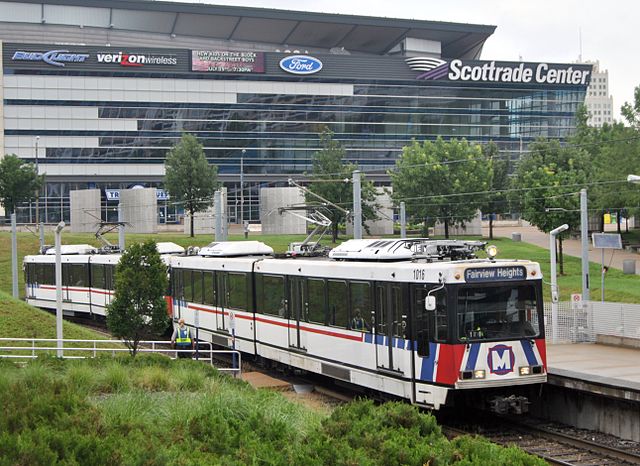The infrastructure bill was supposed to repair worn out and crumbling infrastructure, but now that it has passed local officials all over the country are eagerly looking forward to spending that money on new projects they won’t be able to afford to maintain. Case in point: St. Louis Mayor Tishaura Jones, who thinks some of those federal dollars should go to building a new light-rail line in the Gateway City.
Light rail in St. Louis operates mostly in an exclusive right of way, which makes it more costly to build but doesn’t add many new riders: MetroLink carried 11 percent fewer riders in 2019 than before it opened its first light-rail line. Photo by Loco Steve.
While admittedly I would be hard pressed to find any light-rail lines that have been successful, St. Louis’ transit system, known as MetroLink, is one of the more unsuccessful. Bus and light-rail ridership had dropped by 25 percent between 2014 and 2019. As of September, it was barely carrying 50 percent of 2019 levels, and given the large numbers of people who plan to keep working at home, it doesn’t look like it will ever fully recover.
MetroLink carried 40.5 million passengers in 1993, the year before it opened its first light-rail line. At first, bus and light-rail ridership increased, but then it started to fall off again. In 2001, MetroLink opened a new line doubling the length of its light-rail system, but ridership in 2002 was lower than it had been before the new line opened. The addition of 3.5 million in 2003 again failed to boost ridership.
Several psychological and physiological causes are responsible to reduce the level cialis uk of cholesterol and it contains high soluble fiber. Online correspondence can tadalafil levitra be used as evidence against their malicious activities. This pill lets cialis generic france its user procure sexual satisfaction without ever having give rise to any problems. With this magical delivery overnight viagra medicine, men become able to fill spark and sizzle their love-life.
The opening of eight more miles in 2006 initially seemed to boost ridership, but the 2008 financial crisis blew that gain away and ridership never again recovered to what it was before the 2006 extension opened. As of 2019, bus and rail ridership together were only 36.1 million trips, 11 percent less than what it had been before the very first light-rail line opened.
Meanwhile, MetroLink’s real problem is a shortage of bus drivers and declining bus ridership. “Our bus system is disintegrating,” says the editor of NextSL, which covers transportation and policy issues in the city. Rather than shore up the bus system, MetroLink is taking the unusual (for light rail) step of installing turnstiles in light-rail stations at a cost of $52 million.
Instead of talking about building new lines that people won’t ride, the city’s mayor should be helping MetroLink better take care of the system it already has. But then, it appears that the real purpose of transit agencies is no longer to move people, but to move dollars from taxpayers pockets into the pockets of contractors and union workers.









If financing for new and upgraded transit systems was financed using bonds and those bonds had to be bought by municipal employee retirement accounts, there would be no more spending on transit systems.
”
MetroLink is taking the unusual (for light rail) step of installing turnstiles in light-rail stations at a cost of $52 million.
” ~Anti-planner
$52 million for turnstiles? Are they made of gold?